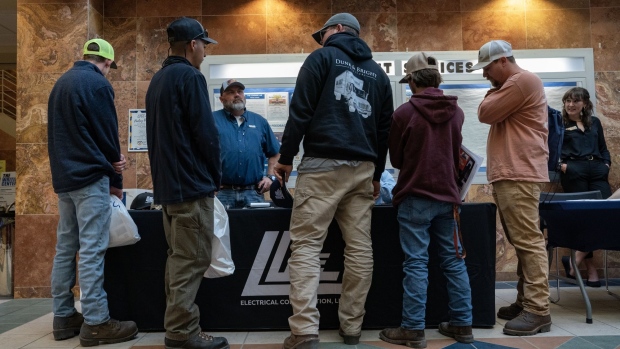Apr 7, 2023
Job Market Softens Only a Bit, Keeping Fed on Track for May Hike
, Bloomberg News

(Bloomberg) -- US payrolls rose at a firm pace last month with the unemployment rate dropping again near record lows, paving the way for the Federal Reserve to increase interest rates at its next meeting.
Nonfarm payrolls increased 236,000 — in line with forecasts — after an upwardly revised 326,000 advance in February, the Bureau of Labor Statistics said Friday. The unemployment rate fell to 3.5%.
There were signs of cooling, with annual wages rising at the slowest pace since June 2021. But overall the March data — following strong readings in the prior two months — paint a picture of resilient labor demand that is particularly remarkable as other parts of the economy slow. Payrolls have jumped by more than 1 million since the start of the year.
“While the data are a bit mixed, the labor market is strong enough and inflation still elevated and sticky to lead the Fed to raise rates another 25 basis points in May,” said Kathy Bostjancic, chief economist at Nationwide Life Insurance Co. That “could be the last for the tightening cycle, followed by a long pause.”
Read more: Fed Traders Boost May Hike Bets
This is the last jobs report Fed officials will have in hand before their May 2-3 policy meeting, but they’ll get a few more readings on inflation and employment costs in the meantime. Policymakers have stuck to their message that rates must go a bit higher and stay there all year to combat inflation despite recent stress in the banking sector.
Average hourly earnings on a monthly basis rose at a comfortable pace of 0.3%. Fed officials have paid special attention to compensation metrics as strong pay gains have given Americans the ability to keep spending, exerting upward pressure on prices.
The figures suggest that supply and demand of workers are coming more into balance, which, if sustained, could help moderate wage gains further. Many companies — particularly small businesses and those in the service sector — are still struggling to attract and retain workers due to persistent labor shortages.
The labor force participation rate — the share of the population that is working or looking for work — ticked up to 62.6%, the highest in three years and reflecting improvement for men and those ages 55 and older.
There was good news for other groups, too.
Hiring was concentrated in a handful of sectors like leisure and hospitality as well as healthcare, which have been struggling with acute labor shortages.
That said, others are hitting the brakes on hiring in response to weaker demand. The report showed employers shed jobs in retail trade and temporary help services. Additionally, the number of permanent job losers jumped by the most since 2020.
Layoffs that initially started in sectors including technology and banking — which went on hiring sprees during the pandemic — are now beginning to spread to other industries. General Motors Co. cut 5,000 jobs through voluntary deals this week, while Walmart Inc. is reducing warehouse staffing across the country.
Treasury yields and the dollar rose on thin trading following the data. The US stock market is closed in observance of Good Friday.
What Bloomberg Economics Says...
“The labor market is gradually softening... The slow pace of deceleration flags the risk that the unemployment rate will undershoot the median FOMC participant’s end-year forecast of 4.5% — in which case, the Fed will have to hike a couple more times after May.”
— Anna Wong and Stuart Paul, economists
To read the full note, click here
The details of the report suggest the labor market is cooling at the margins. The average workweek declined to 34.4 hours, matching the lowest since April 2020. That’s potentially worrisome because employers tend to cut hours before staff when demand wanes.
Read more: Americans Shave a Half-Hour Off Workweek, in Problem for Fed
Temporary jobs — also a leading indicator of the job market because they’re the first to be added when demand is picking up and the easiest to cut when growth is slackening — dropped. A separate index of demand for temporary and contract workers has ebbed in seven of the last eight weeks.
Other data this week also pointed to lower demand for workers. Job openings in February dropped below 10 million for the first time in almost two years, while revisions to unemployment applications data boosted the figures to a level that’s more aligned with recent layoffs.
A separate report Thursday showed the share of US small-business owners who plan to add workers in coming months slipped in March to the lowest since May 2020. The full report, which will include data on small-business optimism and credit conditions, will be released April 11.
--With assistance from Chris Middleton, Reade Pickert, Steve Matthews, Michael Mackenzie and Alex Tanzi.
(Updates headline and first paragraph, adds small business hiring plans)
©2023 Bloomberg L.P.





